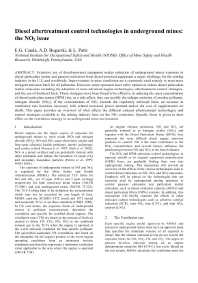Mining Publication: Diesel Aftertreatment Control Technologies in Underground Mines: The NO2 Issue
Original creation date: June 2010
Extensive use of diesel-powered equipment makes reduction of underground miner exposure to diesel particulate matter and gaseous emissions from diesel-powered equipment a major challenge for the mining industry in the U.S. and worldwide. Improvements in mine ventilation are a commonly used remedy to meet more stringent emission limit for all pollutants. However, mine operators have other options to reduce diesel particulate matter emissions including the adoption of more advanced engine technologies, aftertreatment control strategies, and the use of biodiesel fuels. These strategies have been found to be effective in reducing the mass concentration of diesel particulate matter (DPM) but, as a side effect, they can modify the tailpipe emission of another pollutant, nitrogen dioxide (NO2). If the concentration of NO2 exceeds the regulatory enforced limit, an increase in ventilation rate becomes necessary with related increased power demand and/or the cost of supplemental air shafts. This paper provides an overview of what effects the different exhaust aftertreatment technologies and control strategies available to the mining industry have on the NO2 emissions. Specific focus is given to their effect on the ventilation strategy in an underground mine environment.
Authors: EG Cauda, AD Bugarski, LD Patts
Conference Paper - June 2010
NIOSHTIC2 Number: 20036996
Proceedings of the 13th U.S./North American Mine Ventilation Symposium, Sudbury, Ontario, Canada, June 13-16, 2010. Hardcastle, McKinnon, eds., Sudbury, Ontario, Canada: MIRARCO - Mining Innovation, 2010; :17-24
See Also
- Analysis and Prediction of Longwall Methane Emissions: A Case Study in the Pocahontas No. 3 Coalbed, VA
- Evaluation of the Relative Importance of Coalbed Reservoir Parameters for Prediction of Methane Inflow Rates During Mining of Longwall Development Entries
- Managing Excess Gas Emissions Associated with Coal Mine Geologic Features
- Methane Absorption in Oil Shale and Its Potential Mine Hazard
- Methane Diffusion Parameters for Sized Coal Particles: A Measuring Apparatus and Some Preliminary Results
- Methane Emission Rate Studies in a Northern West Virginia Mine
- Modeling and Prediction of Ventilation Methane Emissions of U.S. Longwall Mines Using Supervised Artificial Neural Networks
- Pressure Monitoring and Observed Effects of Mining at the Oak Grove, AL, Coalbed Degasification Pattern
- Reservoir Rock Properties of Coal Measure Strata of the Lower Monongahela Group, Greene County (Southwestern Pennsylvania), from Methane Control and Production Perspectives
- Three Coal Mine Ventilation Studies Using Sulfur Hexafluoride Tracer Gas
- Page last reviewed: 9/21/2012
- Page last updated: 9/21/2012
- Content source: National Institute for Occupational Safety and Health, Mining Program


 ShareCompartir
ShareCompartir
